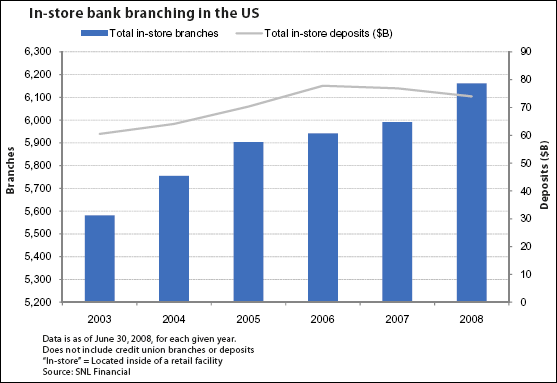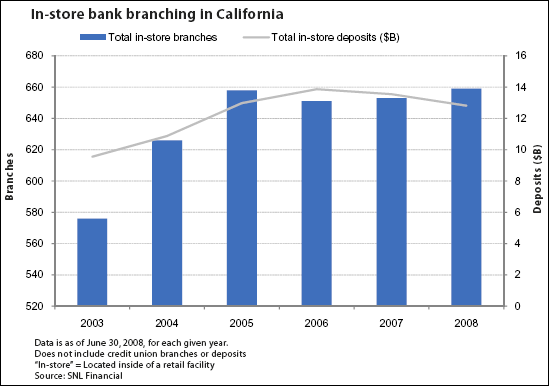In-store Branches Could Boost Growth For Some Banks In The West
By Kevin Dobbs
September 01, 2009
|
|
||||||||||||
Will U.S. banks collectively follow the lead of Bank of America Corp. and begin to shrink their branch networks to save costs and capitalize on Web-based banking?
It depends on whom you ask.
But bankers say this much is certain: In competitive, densely populated western markets — California, in particular — banks are eager to create new and relatively inexpensive contact points with prospective customers in order to take advantage of the disruption caused by the downturn and to position themselves for strong growth when the economy improves.
One such way to accomplish this, some bankers say, is via in-store branches, or bank outlets positioned within grocery, convenience and other retail stores. Though such branches have fallen in and out of favor in recent years, depending on the company and the market, some bankers say now is the time to take advantage of the convenience and steady stream of contacts that in-store banks can provide.

Chico, Calif.-based TriCo Bancshares President and CEO Richard Smith said his bank is committed to steadily opening in-store branches. Speaking at a conference in Chicago earlier in August, Smith said he views in-store branches as a key way to "touch competitors' customers on a frequent basis," estimating that shoppers visit stores such as Wal-Mart, where TriCo does business, at least twice a week on average.
Smith said bank customers are using traditional branches less as they increasingly apply for loans and handle other financial matters online. But in TriCo's case, in-store branches are proving to be successful based on location — few people buy groceries online, he notes — and branches being open seven days a week.
"This gives us a competitive advantage," Smith said. "It's a big reason why we continue to add customers."
TriCo added about $225 million in deposits over the past year, bringing its total to about $1.74 billion, Smith said. In-store deposits and, more importantly, the customer relationships established within stores, drove the increase, he added.
Smith used Sacramento as an example. TriCo, he said, has only one traditional bank branch in California's capital city, but it has about a dozen in-store branches, making it a recognized player in a major market. Smith emphasized what he called the favorable economics of opening an in-store branch. He said his bank essentially commits $250,000 up front for a lease hold and then simply pays rent for the space from there on out.
The cost is much lower than traditional facility, as a stand-alone 3,500-square-foot branch costs about $2.7 million to build and furbish, according to an estimate by consultancy TowerGroup Inc. Factoring in staffing and operational costs, such a branch would need to bring in $40 million in deposits during its first five years to cover all its costs; the average is just under $30 million, according to TowerGroup.

Smith is more candid about strategy than most; many bankers speaking at the same conference in Chicago were hesitant to provide specifics on their branch plans. And even BofA, which confirmed it will scale back its branch total in coming years, declined to provide detailed figures.
A regional bank looking to grow in California and neighboring states, however, said it is looking closely at boosting its in-store branches, according to a source within the company who asked not be named because plans are still being finalized. But talks at the bank center on ways to generate inexpensive core deposits — the key to profitable loan growth — and the general thinking is that, despite the rise of online banking, most customers still open new accounts in person, the source told SNL.
This helps explain why, over the past five years, in-store branches have grown both in number and in deposits.
Between June 30, 2003, and June 30, 2008, total in-store bank branches in the U.S. grew from 5,581 to 6,162, according to an SNL Financial analysis of the most recent FDIC data. Deposits in that time grew from about $60.5 billion to nearly $74 billion. In California, the nation's most populous state, in-store branches grew from 576 in 2003 to 659 in 2008; within that span, deposits grew from about $9.5 billion to $12.8 billion.
"With in-store branches, some banks do it very well; some do not, but in this day and age it is something that makes more sense to consider," Chris Nichols, CEO of Banc Investment Group LLC, told SNL. "It's not only a relatively inexpensive way to capture some deposits, but it can also be an easy and effective way to increase brand awareness."
Despite the expectation that other banks will join BofA and close branches, he and other observers say that new in-store branches could help lift the total number of bank branches in coming years.
Ken Thomas, president of bank consultancy branchlocation.com, said in-store branches "make sense" in a minority of cases, and he advises most banks to instead open stand-alone branches in high-traffic areas. But, he said, the two types of openings likely would combine to increase the total number of bank branches overall. There were about 99,000 U.S. branches as of June 30, 2008. Thomas predicted the total would exceed 100,000 within five years — modest growth, to be sure, but growth nonetheless.
"One thing this crisis has taught us is the value of retail core deposits," Thomas told SNL, "and that means a good franchise, defined as branches in the right markets and at the right corners." The cumulative increase of in-store branches between 2003 and 2008 developed despite pullbacks from some banks that concluded deposit growth came in greater chunks at traditional branches.
Zions Bancorp., for example, said in September of last year that it would close several in-store branches in favor of new, traditional buildings. The Salt Lake City-based company announced plans to build 10 new branches in Utah and exit 21 in-store locations in the state.
"We are continually evaluating our branch locations to ensure we are keeping up with changes in population centers and taking advantage of opportunities in areas experiencing population growth," Zions said at the time.
Some larger banks say they, too, are intent on building new locations, particularly in the West. JPMorgan Chase & Co. Chairman and CEO Jamie Dimon, for one, said during a July conference call that "we're building branches" in California because it is a "very resilient" market that will produce enough population growth to create demand for neighborhood branches.
But observers said some such branches are likely to be smaller than the historical norm and, when it comes to location, many are sure to be situated close to the grocery and convenience stores in which other banks are putting in-store operations.
Dale Gibbons, CFO of Western Alliance Bancorp., said in-store branches are not part of Western's commercial-focused bank strategy. But as an observer of banking in the West, he said he would not be surprised to see more community and regional banks make new pushes in the in-store realm.
"The one thing you have to be careful about — as is always the case in banking — is location," Gibbons told SNL. "You'd have to be careful to make sure you are going into stores that give you the new clientele that you want, rather than simply taking up a notch the whole convenience factor only to wind up serving the same customers you already have.
"But if you do it right, yes, I do think it can work out here."
Maria Tor contributed to this article.
Article updated at 10:38 a.m. ET on Tuesday, Sept. 1, to correct a reference to startup costs of stand-alone branches.
Users who read this story also read: